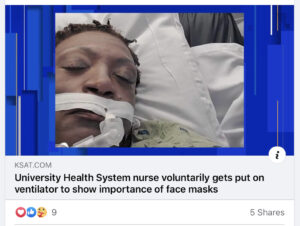by Craig Klugman, Ph.D.
Tommye Austin is senior vice president and chief nursing officer at University Hospital in San Antonio. Like most Texas hospitals, UH has been hard hit by the pandemic in recent weeks and PPE is in short supply. Nurse Austin created a crafty N95 replacement mask that uses cloth fabric and air conditioning filters. She is passionate about masks and people protecting themselves from COVID-19. She regularly posts on social media and has spoken to the media about face coverings.
In late June, to further help her city and social media followers understand why wearing a mask is so important, Austin made a video of recording of her intubation. By showing the procedure as she is sedated and then has the tube inserted, she educated people on why the simplicity of wearing masks could prevent someone from needing this more invasive procedure. This video was carried on KSAT, the local ABC affiliate. Friends and family shared the video on her Facebook page (see image). Days later, the video was gone.
 Was having herself intubated and sharing that procedure ethical? On one side, Austin is a competent and capacitated adult. She probably knows more about this procedure than the vast majority of people who consent for it. Austin likely gave consent to be intubated and she followed public health ethics—undertaking inconvenience to herself in order to inform the community. Because this is not a video of a patient, there are no HIPAA issues.
Was having herself intubated and sharing that procedure ethical? On one side, Austin is a competent and capacitated adult. She probably knows more about this procedure than the vast majority of people who consent for it. Austin likely gave consent to be intubated and she followed public health ethics—undertaking inconvenience to herself in order to inform the community. Because this is not a video of a patient, there are no HIPAA issues.
On the other hand, an anesthesiologist or CRNA performed this procedure on a person who did not medically need it. Intubation is not risk free. The procedure can injure teeth, throat and trachea; cause bleeding and aspiration. The patient is given sedating anesthesia which has associated risks as well. While patients have autonomy to make choices, health care workers have an obligation of nonmaleficence—to do no harm by their actions. An intubation absent a medical need means all of the risks and no potential benefit to the patient.
This case also raises a media ethics issue. Where did the video go? Was it removed at the request of the hospital system? If so, why? As a former journalist, interviewees did not have the right to review material, never mind to tell us not to publish or broadcast it. What power does a hospital have to ask for already broadcast material to be removed? Should a hospital or any entity have that power? Did the television station remove it to preserve good relations? I reached out to Mrs. Austin, University Hospital, and KSAT for comments on the case and did not receive a response even after giving them a week to do so.
The intention of this project was a good one—to educate people on why wearing a mask is so much easier and safer than being intubated. It is a public health service announcement. Perhaps, a better choice would have been finding patients who agreed to be recorded if they should require an intubation. My concerns are with the health care professional who agreed to perform the procedure, and the broadcaster that removed the video like it never existed. However, the accompanying image shows that it did indeed exist.